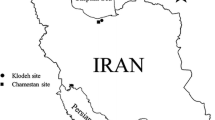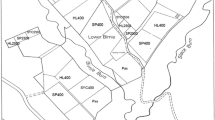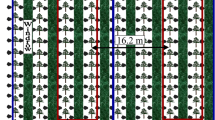Abstract
Carbon storage in aboveground tree biomass and soil organic matter (in depth of A layer development i.e., up to 20 cm) was studied in 22–32 year-old post-mining sites in the northwest of the Czech Republic. Four replicated sites afforested with different tree species (spruce, pine, larch, oak, lime or alder) were compared with sites left to natural regeneration which were dominated by aspen, birch and willow. No topsoil was applied at the sites; hence carbon accumulation resulted from in situ soil development on alkaline tertiary clays that were dumped on the heaps. In aboveground tree biomass, carbon storage ranged from 17.0 ± 5.9 (mean ± SEM) to 67.6 ± 5.9 t ha−1 and the rate of C accumulation increased from 0.60 ± 0.09 to 2.31 ± 0.23 t ha−1 year−1 (natural regeneration < pine < spruce < oak < lime < alder < larch). Carbon storage in soil organic matter varied from 4.5 ± 3.7 to 38.0 ± 7.1 t ha−1 and the rate of C accumulation in soil organic matter increased from 0.15 ± 0.05 to 1.28 ± 0.34 t ha−1 year−1 at sites in the order: natural regeneration < spruce < pine, oak < larch < alder < lime. Carbon storage in the soil was positively correlated with aboveground tree biomass. Soil carbon was equivalent to 98.1% of the carbon found in aboveground tree biomass at lime dominated sites, but only 21.8% at sites with natural regeneration. No significant correlation was found between C storage in soil and aboveground litter input. Total soil carbon storage was correlated positively and significantly with earthworm density, and occurrence of earthworm cast in topsoil, which indicated that bioturbation could play an important role in soil carbon storage. Hence, not only restoring of wood production, but also restoring of soil community is critical for C storage in soil and whole ecosystem.




Similar content being viewed by others
References
Akala VA, Lal R (2000) Potential of mine land reclamation for soil organic carbon sequestration in Ohio. Land Degrad Dev 11:289–297. doi:10.1002/1099-145X(200005/06)11:3<289::AID-LDR385>3.0.CO;2-Y
Allison FE (1973) Soil organic matter and its role in crop production. Elsevier, Amsterdam
Bohlen PJ, Scheu S, Hale CM et al (2004) Non-native invasive earthworms as agents of change in northern temperate forests. Front Ecol Environ 2:427–435
Bossuyt H, Six J, Hendrix PF (2005) Protection of soil carbon by microaggregates within earthworm casts. Soil Biol Biochem 37:251–258. doi:10.1016/j.soilbio.2004.07.035
Bradshaw A (1993) The reconstruction of ecosystems. J Appl Ecol 20:1–17. doi:10.2307/2403372
Brady NC, Weil RR (2002) The nature and properties of soil. Prentice Hall, New Jersey
Cannel MGR, Dewar RC (1995) The carbon sink provided by plantation forests and their production in Britain. Forestry 68:35–48. doi:10.1093/forestry/68.1.35
Chroust L (1985) Above-ground biomass of young pine forests (Pinus sylvestris) and its determination. Communicationes Instituti Forestalis Czechosloveniae 14:127–145
Frouz J (2002) The effect of soil macrofauna on litter decomposition and soil organic matter accumulation during soil formation in spoil heaps after brown coal mining: a preliminary result. Ekologia (Bratisl) 21:363–369
Frouz J, Kalčík J (2006) Accumulation of soil organic carbon in relation to other soil characteristic during spontaneous succession in non-reclaimed colliery spoil heaps after brown coal mining near Sokolov (The Czech Republic). Ekologia (Bratisl) 25:388–397
Frouz J, Keplin B, Pižl V et al (2001) Soil biota and upper soil layers development in two contrasting post-mining chronosequences. Ecol Eng 17:275–284. doi:10.1016/S0925-8574(00)00144-0
Frouz J, Elhottová D, Kuráž V, Šourková M (2006) Effect of soil macrofauna on other soil biota and soil formation in reclaimed and unreclaimed post mining sites: result of field microcosm experiment. Appl Soil Ecol 33:308–320. doi:10.1016/j.apsoil.2005.11.001
Frouz J, Elhottová D, Pižl V et al (2007a) The effect of litter quality and soil faunal composition on organic matter dynamics in post-mining soil: a laboratory study. Appl Soil Ecol 37:72–80. doi:10.1016/j.apsoil.2007.04.001
Frouz J, Pižl V, Tajovský K (2007b) The effect of earthworms and other saprophagous macrofauna on soil microstructure in reclaimed and un-reclaimed post-mining sites in Central Europe. Eur J Soil Biol 43:184–189. doi:10.1016/j.ejsobi.2007.08.033
Frouz J, Prach K, Pižl V et al (2008) Interactions between soil development, vegetation and soil fauna during spontaneous succession in post mining sites. Eur J Soil Biol 44:109–121. doi:10.1016/j.ejsobi.2007.09.002
Garten CT (2002) Soil carbon storage beneath recently established tree plantations in Tennessee and South Carolina, USA. Biomass Bioenergy 23:93–102. doi:10.1016/S0961-9534(02)00033-8
Guggenberger G, Thomas RJ, Zech W (1996) Soil organic matter within earthworm casts of an anecic-endogeic tropical pasture community, Colombia. Appl Soil Ecol 3:263–274. doi:10.1016/0929-1393(95)00081-X
Hochbichler E (2002) Vorläufige Ergebnisse von Biomasseninventuren in Buchen- und Mittelwaldbeständen. In: Dietrich HP, Raspe S, Preushsler T (eds) Inventur von Biomasse- und Nährstoffvorräten in Waldbeständen. Forstliche Forschungsberichte. LWF, München, pp 37–46
Insam H, Domsch KH (1988) Relationship between soil organic carbon and microbial biomass on chronosequences of reclamation sites. Microb Ecol 15:177–188. doi:10.1007/BF02011711
IPCC (2003) Intergovernmental Panel on Climate Change; Good Practice Guidance for Land Use. Land-Use Change and Forestry. IPCC/OECD/IEA/IGES, Hayama, Japan
Irmer U (1995) Die Stellung der Bodenfauna im Stoffhaushat schleswig-holstein Walder. Faunistische Oekologische Mitt 18:1–184
Jackson ML (1958) Soil chemical analysis. Prentice Hall. Inc, Engewood Clifs, New York
Jia S, Akiyama T (2005) A precise, unified method for estimating carbon storage in cool-temperate deciduous forest ecosystems. Agric Meteorol 134:70–80. doi:10.1016/j.agrformet.2005.08.014
Johansson T (1999) Biomass equations for determining fractions of European aspen growing on abandoned farmland and some practical implications. Biomass Bioenergy 17:471–480. doi:10.1016/S0961-9534(99)00073-2
Johansson T (2000) Biomass equations for determining fractions of common and grey alders growing on abandoned farmland and some practical implications. Biomass Bioenergy 18:147–159. doi:10.1016/S0961-9534(99)00078-1
Kempson D, Lloyd M, Ghelardi R (1963) A new extractor for woodland litter. Pedobiologia (Jena) 3:1–21
Ker MF (1980) Tree biomass equations for ten major species in Cumberland County, Nova Scotia. Can For Serv Marit For Res Cent Inf Rep M-X 148:54
Kooistra MJ (1991) A micromorphological approach to the interactions between soil structure and soil biota. Agric Ecosyst Environ 34:315–328. doi:10.1016/0167-8809(91)90117-G
Kříbek B, Strnad M, Boháček Z et al (1998) Geochemistry of Miocene lacustrine sediments from the Sokolov Coal Basin (Czech Republic). Int J Coal Geol 37:207–233. doi:10.1016/S0166-5162(98)00002-0
Ladegaard-Pedersen P, Elberling B, Vesterdal L (2005) Soil carbon stocks, mineralization rates, and CO2 effluxes under 10 tree species on contrasting soil types. Can J For Res 35:1277–1284. doi:10.1139/x05-045
Lavelle P, Martin A (1992) Small-scale and large-scale effect of endogeic earthworms on soil organic matter dynamics in soil of humid tropics. Soil Biol Biochem 24:1491–1498. doi:10.1016/0038-0717(92)90138-N
Lavelle P, Bignell D, Lepage M (1997) Soil function in changing world: the role of invertebrate ecosystem engineers. Eur J Soil Biol 33:159–193
Marklund LG (1988) Biomassafunktioner för tall, gran och björk i Sverige. Sveriges Lantbruksuniversitet. Rapporter-Skog 45:1–73
McInerney M, Bolger T (2000) Decomposition of Quercus petraea litter: influence of burial, comminution and earthworms. Soil Biol Biochem 32:1989–2000. doi:10.1016/S0038-0717(00)00097-3
Metting FB, Smith JL, Amthor JS et al (2001) Science needs a new technology for increasing soil carbon sequestration. Clim Change 51:11–34. doi:10.1023/A:1017509224801
Nieuwenhuis M, Redmond J, O’Donovan C (eds) (2007) National Forest Inventory—Republic of Ireland-Methodology. Forest Service, Dept. Agriculture, Fisheries and Food, Ireland, ISBN 0-7557-7562-7, pp. 124
Niu XZ, Duiker SW (2006) Carbon sequestration potential by afforestation of marginal agricultural land in the Midwestern US. For Ecol Manage 223:415–427. doi:10.1016/j.foreco.2005.12.044
Peichl M, Thevathasan N, Gordon AM, Huss J, Abohassan RA (2006) Carbon sequestration potentials in temperate tree-based intercropping systems, southern Ontario, Canada. Agrofor Syst 66:243–257. doi:10.1007/s10457-005-0361-8
Pižl V (2001) Earthworm succession in afforested colliery spoil heaps in the Sokolov region, Czech Republic. Restor Ecol 9:359–364. doi:10.1046/j.1526-100X.2001.94004.x
Ponge JF (2003) Humus form in terrestrial ecosystem: a framework to biodiversity. Soil Biol Biochem 35:935–945. doi:10.1016/S0038-0717(03)00149-4
Schafer WM, Nielsen GA, Dollhopf DJ et al (1979) Soil genesis, hydrological properties, root characteristics and microbial activity of 1 to 50-year old stripmine spoils. EPA-600/7–79-100. Environmental Protection Agency, Cincinnati, Ohio
Scullion J, Malik A (2000) Earthworm activity affecting organic matter aggregation and microbial activity in soils restored after opencast mining for coal. Soil Biol Biochem 32:119–126. doi:10.1016/S0038-0717(99)00142-X
Six J, Conanat RT, Paul EP et al (2002) Stabilisation mechanism of soil organic mater: implicatin for C saturation of soil. Plant Soil 241:155–176. doi:10.1023/A:1016125726789
Skukla MK, Lal R (2005) Temporal changes in soil organic carbon concentration and stocks in reclaimed minesoils of southeastern Ohio. Soil Sci 170:1013–1021. doi:10.1097/01.ss.0000187354.62481.91
Šourková M, Frouz J, Šantrůčková H (2005) Accumulation of carbon, nitrogen and phosphorus during soil formation on alder spoil heaps after brown-coal mining, near Sokolov (Czech Republic). Geoderma 124:203–214. doi:10.1016/j.geoderma.2004.05.001
Sparling GP, Wheeler D, Esely ET et al (2006) What is soil organic matter worth? J Environ Qual 35:548–557. doi:10.2134/jeq2005.0230
Stewart VI, Scullion J (1988) Earthworm, soil structure and the rehabilitation of former opencast coal mining land. In: Edwards CA, Neuhauser EF (eds) Earthworms in waste and environmental management. Academic Publishing, Hague
Stewart VI, Scullion J (1989) Principles of managing man-made soils. Soil Use Manage 5:109–116. doi:10.1111/j.1475-2743.1989.tb00770.x
Ter-Mikaelian MT, Korzukhin MD (1997) Biomass equations for sixty-five North American tree species. For Ecol Manage 97:1–24. doi:10.1016/S0378-1127(97)00019-4
Ussiri DAN, Lal R, Jacinthe PA (2006) Post-reclamation land use effects on properties and carbon sequestration in minesoils of southeastern Ohio. Soil Sci 171:261–271. doi:10.1097/01.ss.0000199702.68654.1e
Utkin AI, Zamolodchikov DG, Gul’be TA et al (1996) Allometric equations for phytomass based on the data on pine, birch and aspen trees in European Russia. Lesovedenie 6:36–46
Wachendorf C, Irmler U, Blume HP (1997) Relationships between litter fauna and chemical changes of litter during decomposition under different moisture conditions. In: Cadisch G, Giller KE (eds) Driven by Nature: Plant litter quality and decomposition. Walingford
Walle VI, Mussche S, Samson R, Lust N, Lemeur R (2001) The above- and belowground carbon pools of two mixed deciduous forest stands located in East-Flanders (Belgium). Ann For Sci 58:507–517. doi:10.1051/forest:2001141
Wironen M, Moore TR (2006) Exotic earthworm invasion increases soil carbon and nitrogen in an old-growth forest in southern Quebec. Can J For Res 36:845–854. doi:10.1139/X06-016
Wirth C, Schumacher J, Schulze ED (2004) Generic biomass functions for Norway spruce in Central Europe - a-meta-analysis approach toward prediction and uncertainty estimation. Tree Physiol 24:121–139
Wolters V (2000) Invertebrate control of soil organic matter stability. Biol Fertil Soils 31:1–19. doi:10.1007/s003740050618
Zhang XD, Ang J, Xie HT et al (2003) Comparison of organic compounds in the particle-size fractions of earthworm casts and surrounding soil in humid Laos. Appl Soil Ecol 23:147–153. doi:10.1016/S0929-1393(03)00020-9
Zhao-gang L, Feng-ri L (2003) The generalized Chapman-Richards function and applications to tree and stand growth. J For Res 14:19–26
Zou X, Bashkin M (1998) Soil carbon accretion and earthworm recovery following revegetation in abandoned sugarcane fields. Soil Biol Biochem 30:825–830
Acknowledgments
This study was supported by the grant no 2B8023, Academy of Sciences of the Czech Republic (grant No. S600660505) and by Sokolovska uhelna a.s. coal mining company. We also thank the Sokolovska uhelna for the research permit and technical information about the plot history. Our thanks go to Mr. Josef Jerhot and Ms. Jitka Weydova for the field assistance and preparation of thin soil sections. Dr. Pat Noris is thanked for language improvements.
Author information
Authors and Affiliations
Corresponding author
Rights and permissions
About this article
Cite this article
Frouz, J., Pižl, V., Cienciala, E. et al. Carbon storage in post-mining forest soil, the role of tree biomass and soil bioturbation. Biogeochemistry 94, 111–121 (2009). https://doi.org/10.1007/s10533-009-9313-0
Received:
Accepted:
Published:
Issue Date:
DOI: https://doi.org/10.1007/s10533-009-9313-0




